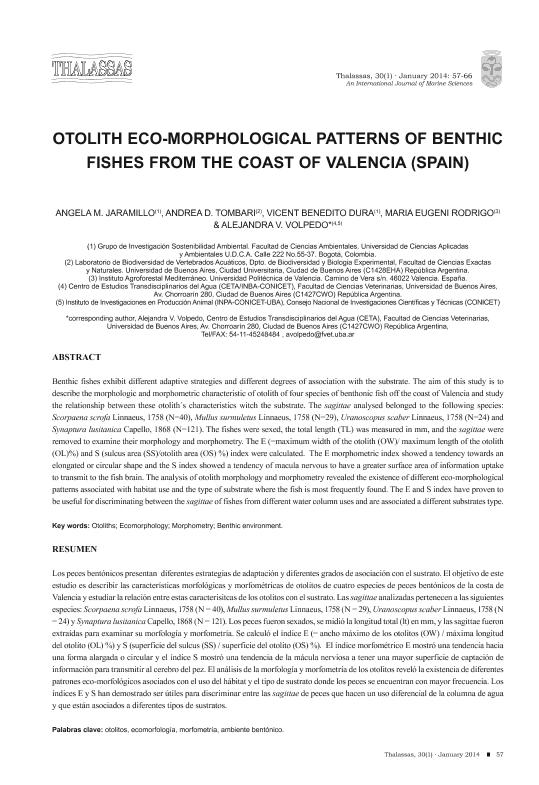Mostrar el registro sencillo del ítem
dc.contributor.author
Jaramillo, Angela M.
dc.contributor.author
Tombari, Andrea D.
dc.contributor.author
Benedito Dura, Vicent
dc.contributor.author
Rodrigo, Maria Eugeni
dc.contributor.author
Volpedo, Alejandra

dc.date.available
2016-11-09T20:43:59Z
dc.date.issued
2014-01
dc.identifier.citation
Jaramillo, Angela M.; Tombari, Andrea D.; Benedito Dura, Vicent; Rodrigo, Maria Eugeni; Volpedo, Alejandra; Otolith eco-morphological patterns of benthic fishes from the coast of Valencia (Spain); Univ Vigo; Thalassas (santiago de Compostela); 30; 1; 1-2014; 57-66
dc.identifier.issn
0212-5919
dc.identifier.uri
http://hdl.handle.net/11336/8104
dc.description.abstract
Benthic fishes exhibit different adaptive strategies and different degrees of association with the substrate. The aim of this study is to describe the morphologic and morphometric characteristic of otolith of four species of benthonic fish off the coast of Valencia and study the relationship between these otolith´s characteristics witch the substrate. The sagittae analysed belonged to the following species: Scorpaena scrofa Linnaeus, 1758 (N=40), Mullus surmuletus Linnaeus, 1758 (N=29), Uranoscopus scaber Linnaeus, 1758 (N=24) and Synaptura lusitanica Capello, 1868 (N=121). The fishes were sexed, the total length (TL) was measured in mm, and the sagittae were removed to examine their morphology and morphometry. The E (=maximum width of the otolith (OW)/ maximum length of the otolith (OL)%) and S (sulcus area (SS)/otolith area (OS) %) index were calculated. The E morphometric index showed a tendency towards an elongated or circular shape and the S index showed a tendency of macula nervous to have a greater surface area of information uptake to transmit to the fish brain. The analysis of otolith morphology and morphometry revealed the existence of different eco-morphological patterns associated with habitat use and the type of substrate where the fish is most frequently found. The E and S index have proven to be useful for discriminating between the sagittae of fishes from different water column uses and are associated a different substrates type.
dc.description.abstract
Los peces bentónicos presentan diferentes estrategias de adaptación y diferentes grados de asociación con el sustrato. El objetivo de este estudio es describir las características morfológicas y morfométricas de otolitos de cuatro especies de peces bentónicos de la costa de Valencia y estudiar la relación entre estas caracterisitcas de los otolitos con el sustrato. Las sagittae analizadas pertenecen a las siguientes especies: Scorpaena scrofa Linnaeus, 1758 (N = 40), Mullus surmuletus Linnaeus, 1758 (N = 29), Uranoscopus scaber Linnaeus, 1758 (N = 24) y Synaptura lusitanica Capello, 1868 (N = 121). Los peces fueron sexados, se midió la longitud total (lt) en mm, y las sagittae fueron extraídas para examinar su morfología y morfometría. Se calculó el índice E (= ancho máximo de los otolitos (OW) / máxima longitud del otolito (OL) %) y S (superficie del sulcus (SS) / superficie del otolito (OS) %). El índice morfométrico E mostró una tendencia hacia una forma alargada o circular y el índice S mostró una tendencia de la mácula nerviosa a tener una mayor superficie de captación de información para transmitir al cerebro del pez. El análisis de la morfología y morfometría de los otolitos reveló la existencia de diferentes patrones eco-morfológicos asociados con el uso del hábitat y el tipo de sustrato donde los peces se encuentran con mayor frecuencia. Los índices E y S han demostrado ser útiles para discriminar entre las sagittae de peces que hacen un uso diferencial de la columna de agua y que están asociados a diferentes tipos de sustratos.
dc.format
application/pdf
dc.language.iso
eng
dc.publisher
Univ Vigo

dc.rights
info:eu-repo/semantics/openAccess
dc.rights.uri
https://creativecommons.org/licenses/by-nc-sa/2.5/ar/
dc.subject
Otolito
dc.subject
Peces Comerciales
dc.subject.classification
Pesca

dc.subject.classification
Agricultura, Silvicultura y Pesca

dc.subject.classification
CIENCIAS AGRÍCOLAS

dc.title
Otolith eco-morphological patterns of benthic fishes from the coast of Valencia (Spain)
dc.type
info:eu-repo/semantics/article
dc.type
info:ar-repo/semantics/artículo
dc.type
info:eu-repo/semantics/publishedVersion
dc.date.updated
2016-11-07T15:40:17Z
dc.journal.volume
30
dc.journal.number
1
dc.journal.pagination
57-66
dc.journal.pais
España

dc.journal.ciudad
Vigo
dc.description.fil
Fil: Jaramillo, Angela M.. Universidad de Ciencias Aplicadas y Ambientales; Colombia
dc.description.fil
Fil: Tombari, Andrea D.. Universidad de Buenos Aires. Facultad de Ciencias Exactas y Naturales; Argentina
dc.description.fil
Fil: Benedito Dura, Vicent. Universidad de Ciencias Aplicadas y Ambientales; Colombia
dc.description.fil
Fil: Rodrigo, Maria Eugeni. Universidad Politecnica de Valencia. Dpto.de Ingenieria, Hidraulica y Medio Ambiente; España
dc.description.fil
Fil: Volpedo, Alejandra. Consejo Nacional de Investigaciones Científicas y Técnicas. Oficina de Coordinación Administrativa Parque Centenario. Unidad Ejecutora de Investigaciones En Produccion Animal; Argentina. Universidad de Buenos Aires. Facultad de Ciencias Veterinarias. Centro de Estudios Transdisciplinarios del Agua; Argentina
dc.journal.title
Thalassas (santiago de Compostela)

dc.relation.alternativeid
info:eu-repo/semantics/altIdentifier/url/http://thalassas.webs.uvigo.es/Thalasas%2030(1)/006%20Thalassas%2030(1).pdf
Archivos asociados
